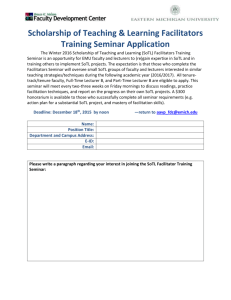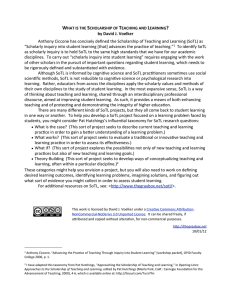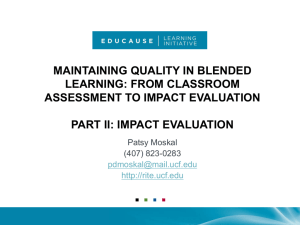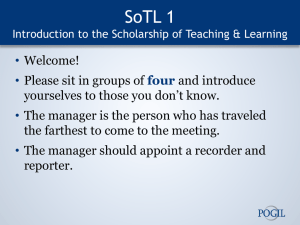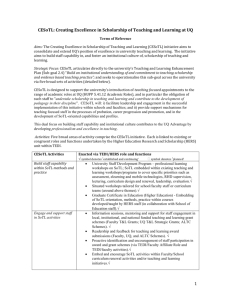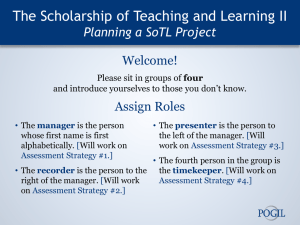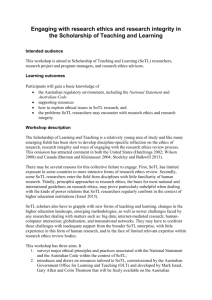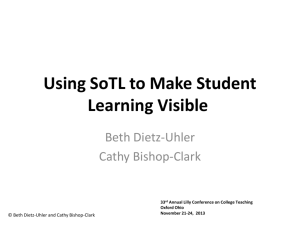Why SoTL? Why Now? The Scholarship of
advertisement
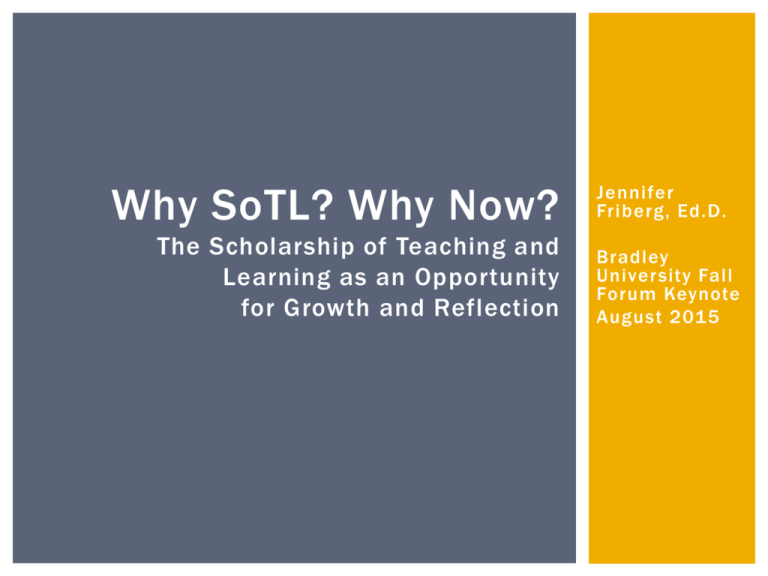
Why SoTL? Why Now? The Scholarship of Teaching and Learning as an Opportunity for Growth and Reflection Jennifer Friberg, Ed.D. Bradley University Fall Forum Keynote August 2015 Goals for this morning: Define and explain the scholarship of teaching and learning (SoTL) Contrast the concepts of good teaching, scholarly teaching, and the scholarship of teaching and learning Explore the benefits of SoTL for individual courses, academic programs/departments, and the Bradley University community atlarge The Evolution of SoTL: Boyer’s Four Scholarships Discovery Integration Application Teaching (Boyer, 1990) The Teaching Continuum Good Teaching Teaching that promotes student learning and other desired student outcomes ( M c Ki nney, 2 0 07 ) Scholarly Teaching Scholarship of Teaching and Learning Teaching that is supported by a body of research to increase effectiveness Combination of reflection and knowledge which yields questions about teaching for study Working within the continuum How might teachers at different points along this continuum handle the following situation: In an introduction to psychology class at a lar ge Midwester n univer sity, the cour se instr uctor notices that her students tend to be reluctant to engage in whole-class discussions. What might the good teacher do? What might a scholarly teacher do? How could this be studied in a scholarly manner? What is SoTL? Poses a problem related to teaching and learning Problem is operationalized into a research question Problem is studied using methods appropriate for specific disciplinary epistemologies Work is peer reviewed Results are applied to practice (McKinney, 2007) Contemporary Conception of SoTL Focused on improving teaching or learning Disseminated beyond researcher Systematic examination Scholarship of Teaching and Learning Why Engage in SoTL? To develop a report on an aspect of one particular course To describe the interaction of several courses or the student experience across courses To reflect on teaching practices/pedagogical choices from teaching (perhaps over time) To investigate interdisciplinary commonalities To synthesize existing SoTL work To propose or test new learning theories Why engage in SoTL: To improve PCK Disciplinary Content Knowledge PCK General Pedagogical Knowledge (Pedagogical Content Knowledge ; Schulman, 2004) How to SoTL: Potential Data Collection Tools Course portfolios Specific course artifacts (e.g., assignments/projects/assessments) Interviews Focus groups Questionnaires/surveys Content analysis Multi-method studies How is SoTL Disseminated? SoTL is disseminated in ways consistent with your disciplinary expectations: Internal/external publications traditional research papers/research notes book blog wiki creative endeavor documentary artistic representation Benefits of SoTL: Individual Course Level To better understand how your students learn To identify ways to deal with unique situational constraints To determine the impact of an assignment, project, or assessment technique To compare and contrast pedagogical approaches Benefits of SoTL: The utility of teaching problems Bass (1999) posits that teaching problems aren’t shameful… they are actually opportunities for faculty. From Vanderbilt University’s CFT Homepage Benefits of SoTL: Academic Unit Curriculum review Curriculum development Accreditation Program review Formative/summative assessment Benefits of SoTL: Institutional Level Budget Accreditation Curriculum Redesign Assessment SoTL Strategic Planning Program Review Student Affairs Future Directions For SoTL (Hutchings, 2015) 1. SoTL needs to be a part of regular practices of teaching so that any/all pedagogical choices are evidence-based. 2. SoTL needs to be more integrated into institutional policies and agendas to ensure a greater impact into new and ongoing formative and summative assessment efforts. 3. SoTL needs to engage students, more fully, as research associates and collaborators to encourage a reflective/metacognitive focus up on their learning and the learning of their peers. Why Is Now A Good Time For SoTL? Bradley University Core Curriculum Implementation is planned Core Outcomes can be measurable at class, program, or institutional levels Critical and creative thinking Effective communication Multidisciplinary integration Practical application Social awareness Critical And Creative Thinking Bradley graduates will think critically, independently and creatively, and will employ evidence-based decision-making to solve problems and build new knowledge. How can this outcome be measured? Track problem solving processes over a semester or academic year for innovation Measure the frequency that students access research to make evidence-informed decisions Determine the level of critical thinking rigor required of students to complete core practice activities Effective Communication Bradley graduates will be effective oral, written and non-verbal communicators as well as active readers and listeners. How can you measure this outcome? Measure changes in peer-peer communications during collaborative activities Measure changes in peer-teacher communications in structured and unstructured situations Multidisciplinary Integration Bradley graduates will approach learning in an integrated manner, connecting knowledge and skills across multiple disciplines. How can this outcome be measured? Assess how able students are to generalize information from one course to the next Determine the success of cross-curricular projects Ascertain student perceptions of how well integrated their curriculum is from their perspective Practical Application Bradley graduates will apply knowledge and skills from the classroom in real-world situations. How can this outcome be measured? Measure how well students are able to apply some aspect of their course curriculum to solve a “real world” problem with the help of professionals outside academia Determine the impact of engaging practicing professionals to teach critical aspects of a discipline Social Awareness Bradley graduates will understand and act ethically upon their connections to larger communities. How can this outcome be measured? Determine if case studies are impactful in teaching about professional ethics Measure the impact of civic engagement in the development of a world knowledge, compassion, or learning Your View of the Possible… REFERENCES Bass, R. (1999). The scholarship of teaching: What’s the problem? Invention: Creative Thinking About Learning and Teaching, 1 (1), 1-10. Boyer, E. L. (1990). Scholarship Reconsidered: Priorities of the Professoriate. San Francisco, CA: Jossey-Bass. Ginsberg, S. M., Friberg, J. C., & Visconti, C. F. (2012). Scholarship of teaching and learning in speech -language pathology and audiology: Evidence -based education. San Diego: Plural Publishing. McKinney, K. (2007). Enhancing learning though the scholarship of teaching and learning: The challenges and joys of juggling. San Francisco, CA: Jossey -Bass. Shulman, L. S. (2004). Teaching As Community Proper ty . San Francisco, CA: Jossey -Bass .
